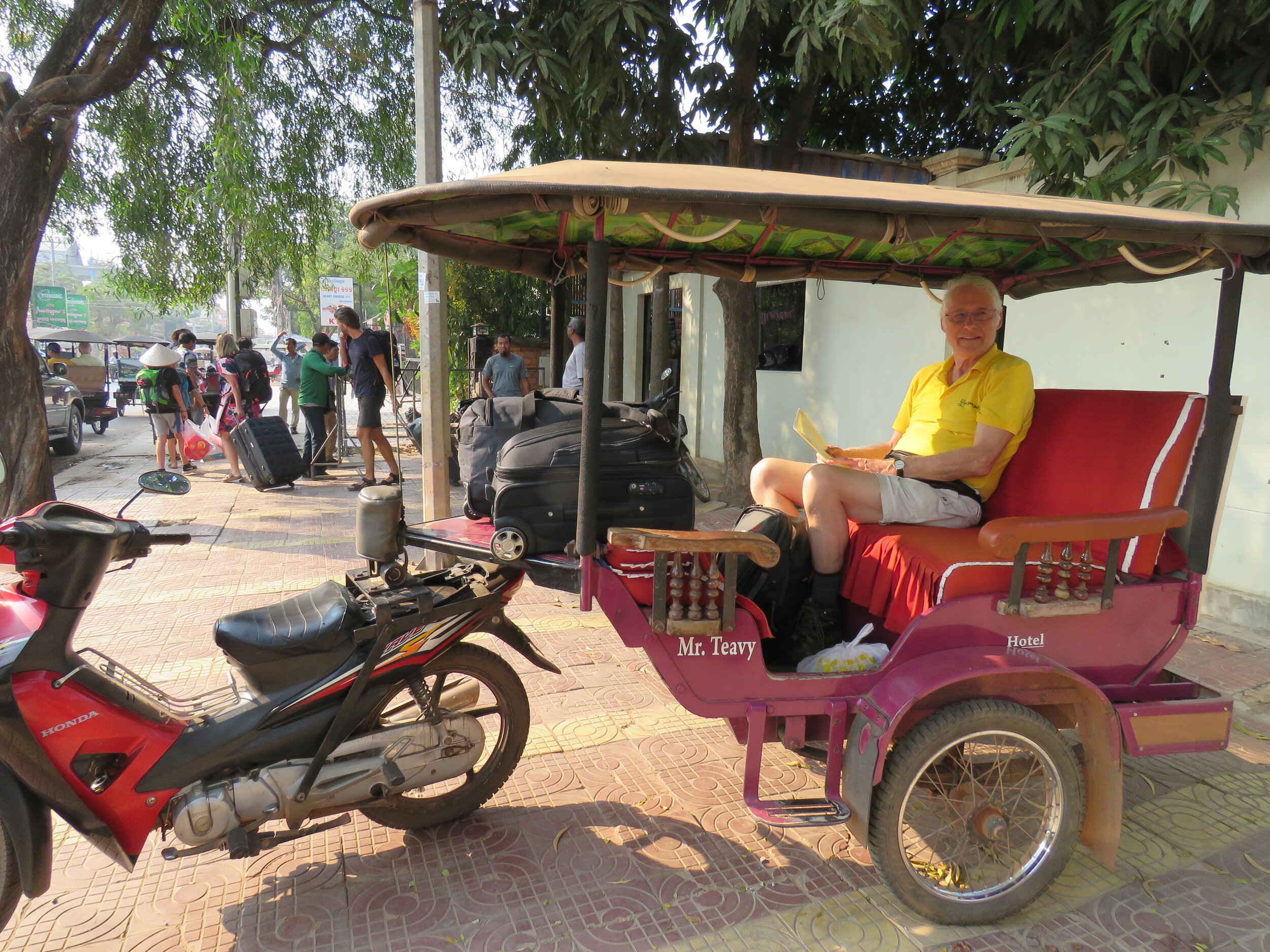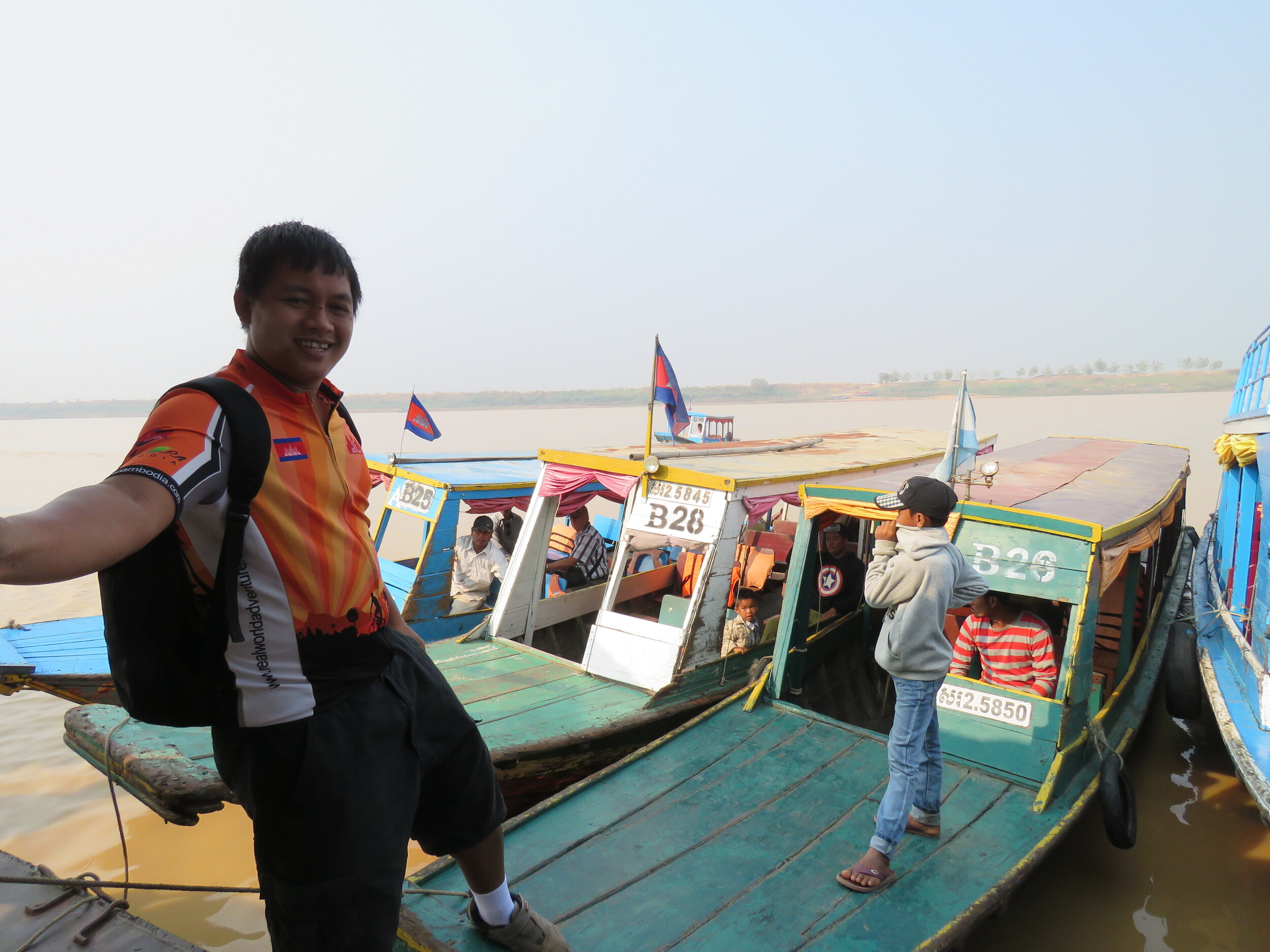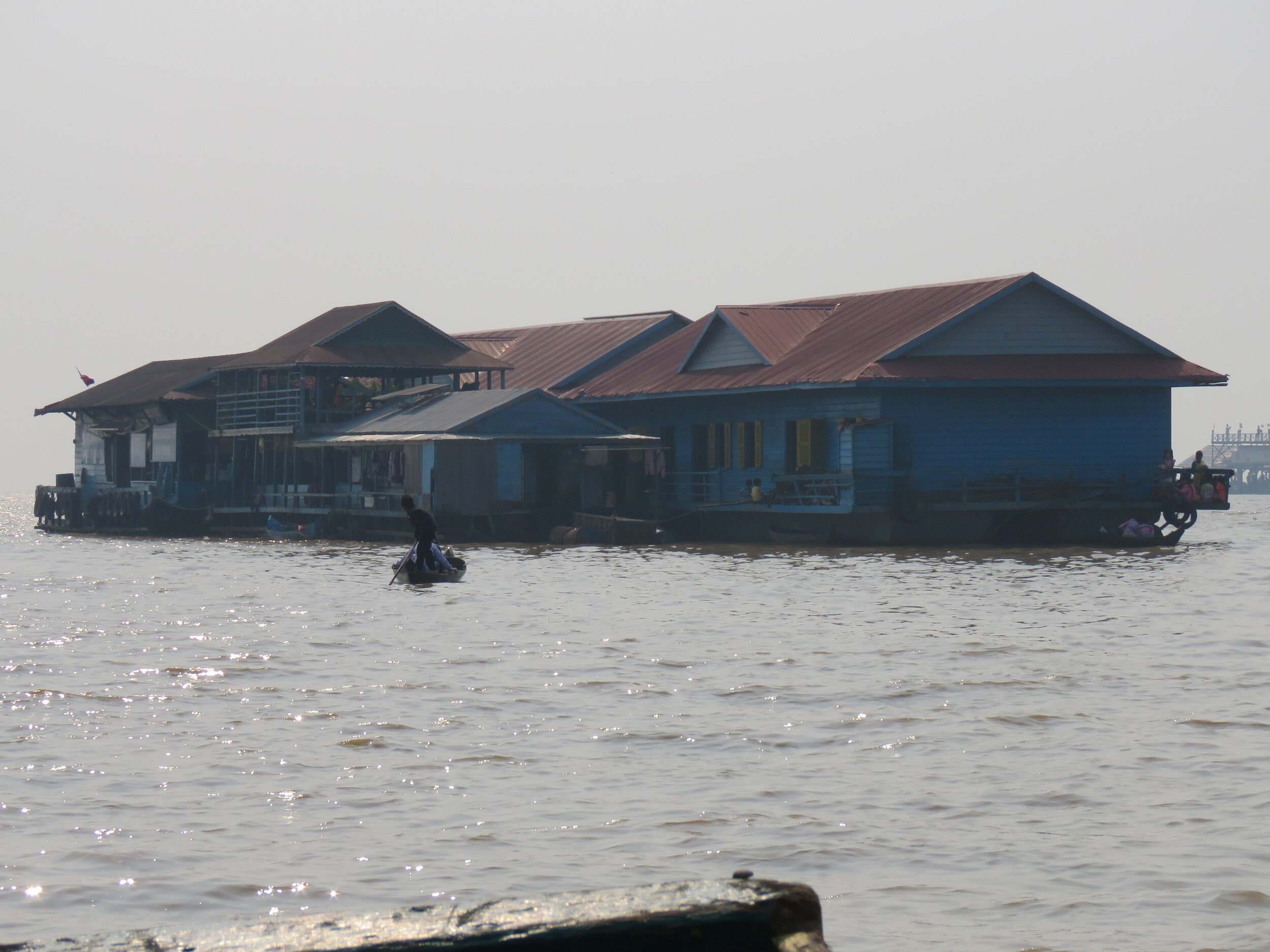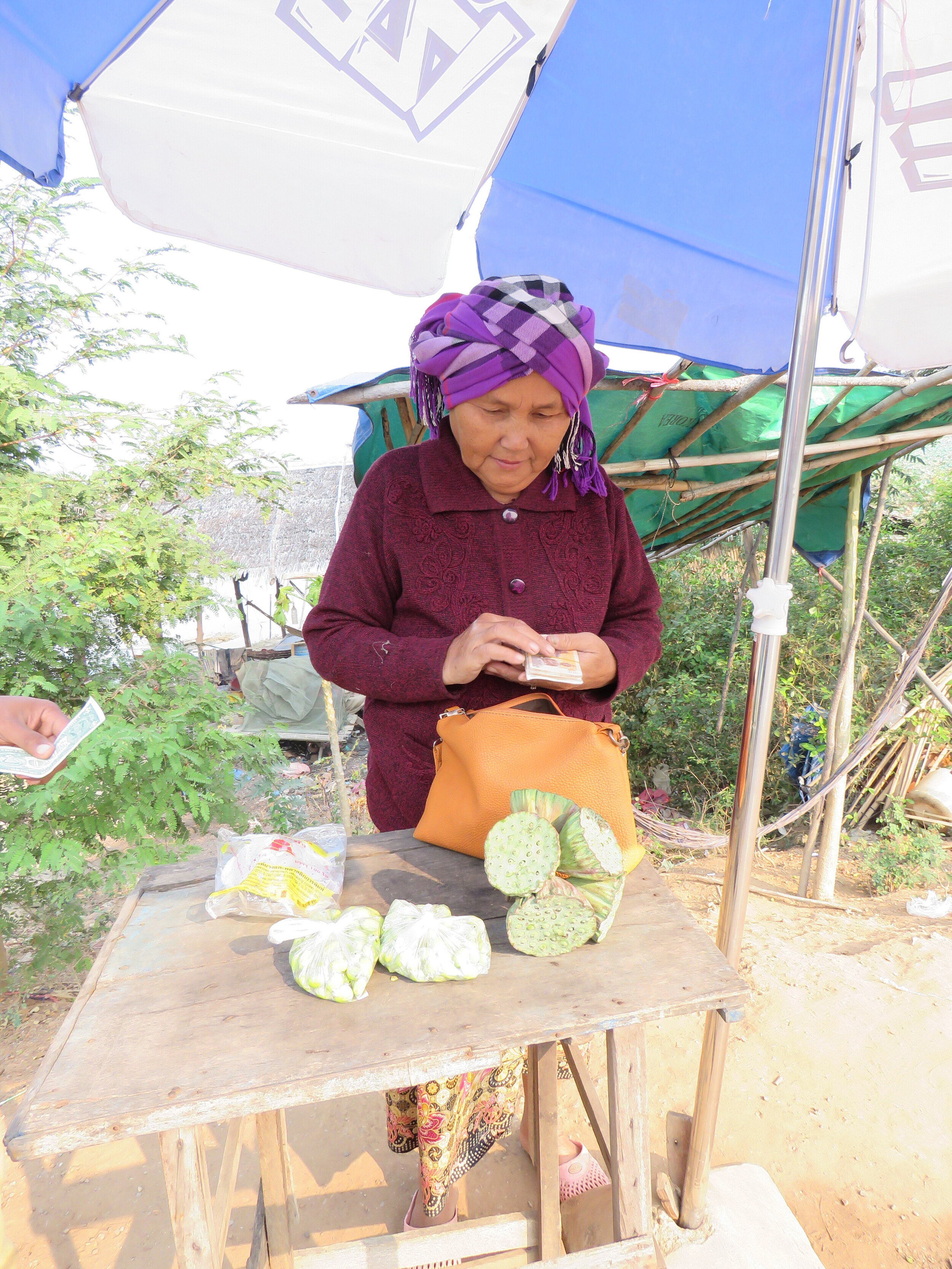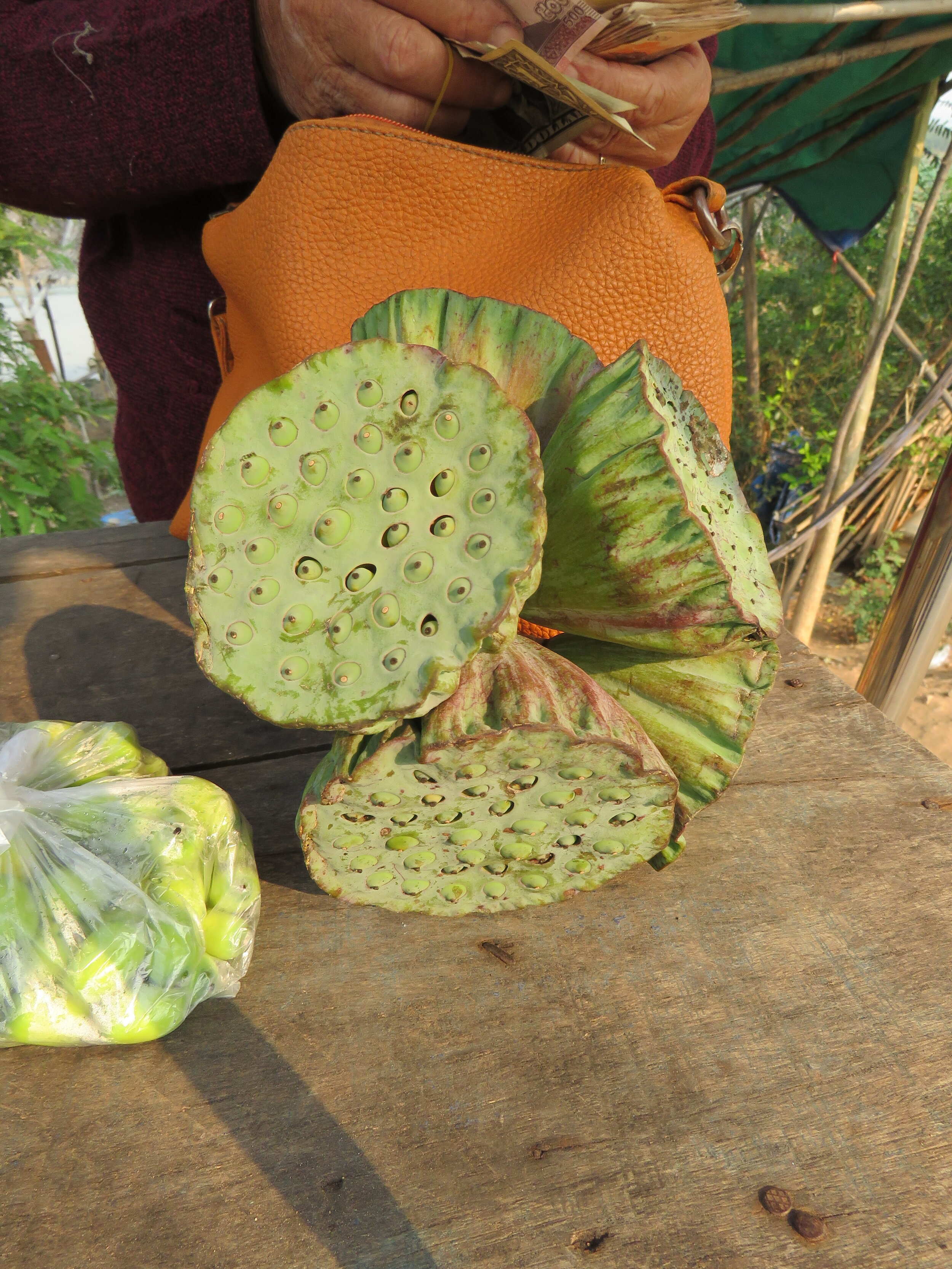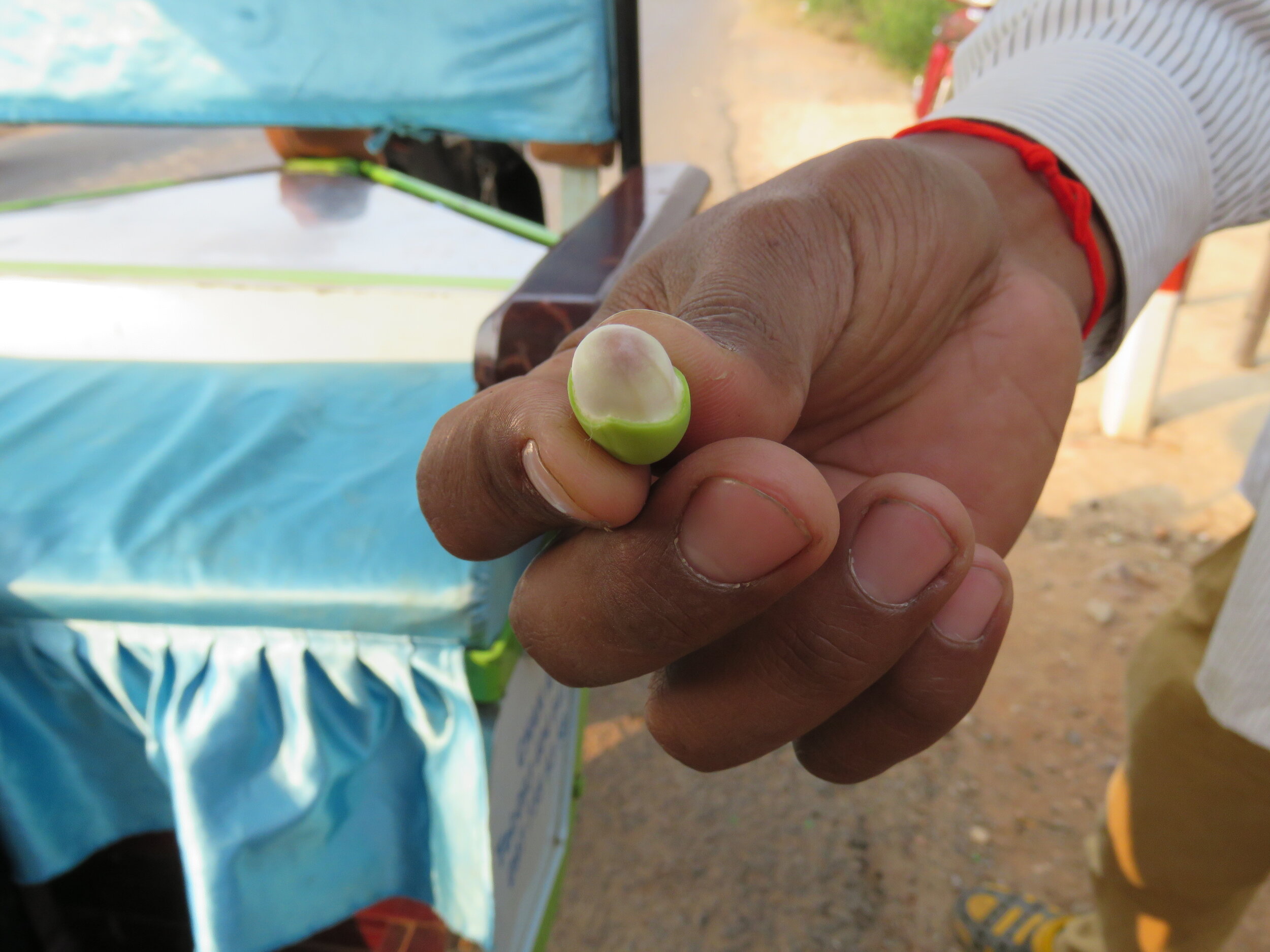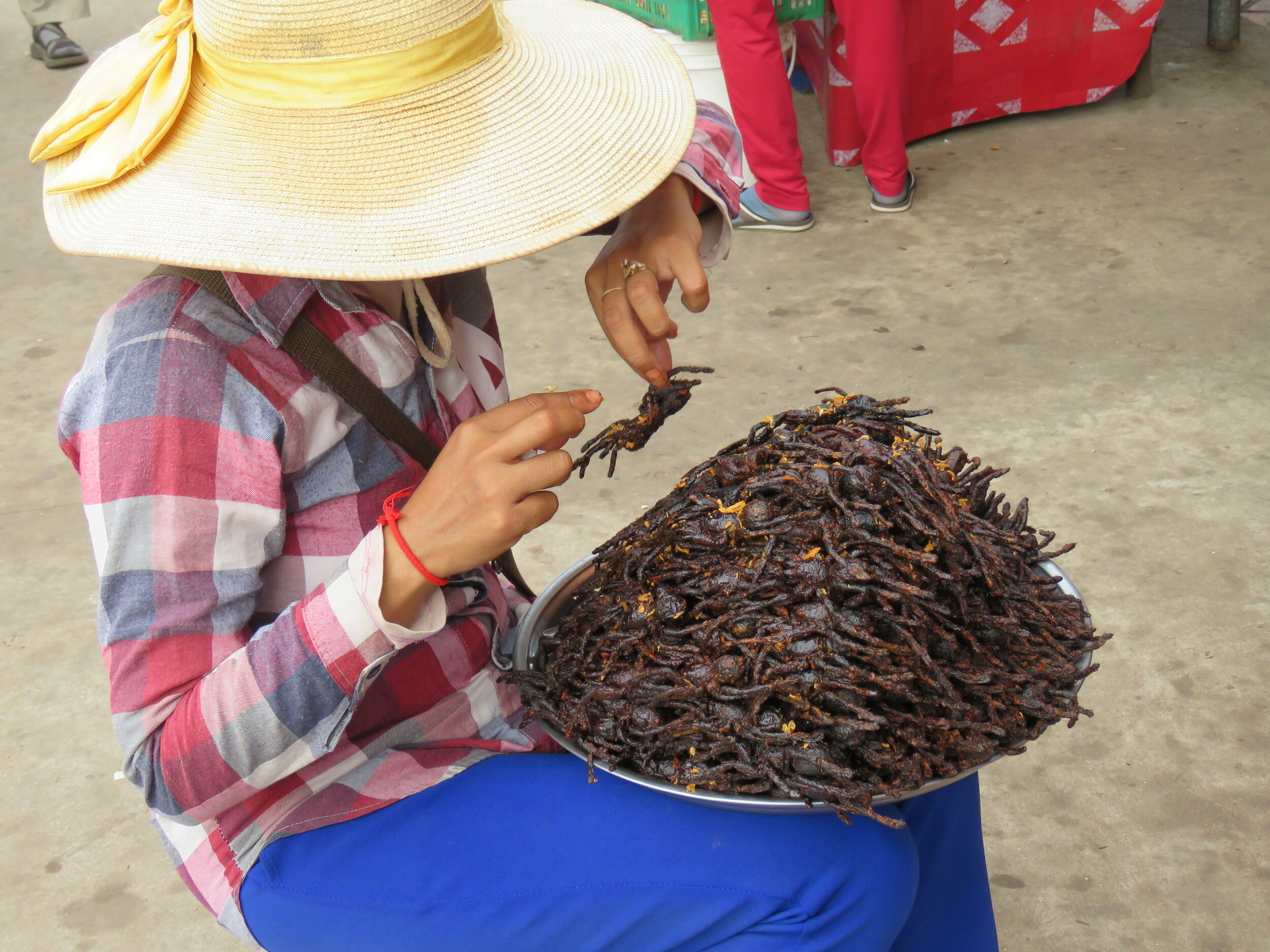Phnom Penh
I wrote a book, My School in the Rain Forest, about unusual schools around the world. My favourite was a floating school in Cambodia. But I had never been there in person. Then I included Cambodia in my book Birthdays Around The World, sharing information about birthday traditions that kind Cambodians helped me to gather.
But I still had not visited Cambodia itself. One night Kees came across the website of Cambodia Cycling and Trekking. He loves hiking and we both like exploring new places. We wanted to go somewhere warm during the winter but sitting on a beach is not for us. He found an itinerary for a 15 day trek in which we would see much of the country, have some home stays or use small hotels, and walk about 100 KMs. The online responses were efficient. We read good reviews of the company and so we booked our trek Cambodia Cycling & Trekking - an eco-friendly tour company that employs locals to guide visitors either on bicycle tours or on hiking trips.
As with all countries we visit, we don’t pretend to know the country after a short stay. We simply want to share the excitement of what we see, do and learn. And Cambodia was awesome.
We flew Cathay Pacific, via Hong Kong, to Cambodia’s capital city Phnom Penh (pronounced Puhnoom Penn). It’s always exciting to finally see the real thing, after seeing so many maps, photos and books about a place.
Even from the air, we noticed loads of motorbikes. We were met by a driver from Cambodia Cycling & Trekking who took us to our downtown hotel - about a 45 minute drive. The city streets got narrower and more crowded as we came into the old city along the river. Our hotel was a lovely colonial building with a restaurant and pool on the roof top.
Despite the time change and long flight, we took a stroll along the river and through on old temple complex. Then we had a swim in the cool pool and enjoyed happy hour with one-dollar-beer and half price piña colada’s. But then we had an amazing sleep after 3 days of traveling and no bed!
Before coming here, we had done research to see how to best travel from Phnom Penh to Siem Reap in the northern part of the country. You can fly, but then you don’t see anything. So we opted for a bus: Giant Ibis busses take 6 hours to drive at a cost of 15.- p.p.. We ordered our tickets online a month ahead, and were able to get front row seats.
Street scene from the bus.
While most people dozed or read, we enjoyed a great view of the countryside and did not have enough eyes to take it all in.
Not our bus!
The driver drove like a bat out of hell and the bus’ tires were so bald that metal wire shone through the smooth rubber. The company advertises with wifi onboard but that did not work for us at all. There is also no bathroom on board - a good thing to realize ahead of time. The road out of P.P. was lined with stalls - some selling fruit, others selling buckets or chickens or clothing or TV’s. Little children walked barefoot along the road, dogs dozed in the red dust. As we left the city, green fields replaced shacks. We spotted the occasional skinny cow. The bus gathered speed. Even as we passed through towns with people crowding along the road, we must have done 120 KPH while passing kids, cows, motorbikes and tuk-tuks. Honking at everything that moved, we managed to avoid hitting things although one deaf dog had a very narrow escape and I kept expecting a motorbike loaded with entire families to swerve into the path of our speeding bus.
Us westerners tend to think of a motorbike as transportation for getting from A to B. Here it is obvious that owning a motorbike means you are well-to-do and that you need to help out friends and neighbors. In one day alone we spotted motorbikes transporting:
Gasoline for sale!
Tuk-tuk loaded with teak bedframes.
Tuk-tuk at Siem Reap bus station.
entire families including babies, toddlers and grandmothers.
a wicker cage with 6 live pigs
armloads bamboo, including one dragging 10 meter poles
large flats of potted mums
loads of bricks
a rack with steaming pots of food
enormous bales of rice piled high
large baskets, on either side, full of bananas and eggs
lumber
hay bales
shoes for sale
piles of bottles of gasoline
terra cotta charcoal burners
large loads of charcoal
fruits and snacks for sale
stacks of about 20 wooden tables (!)
teak carved bed frames
towering piles of mattresses
rolls of fencing
dried fish
firewood
coconuts and mangoes
tires
and a cargo bike with a cow
When our bus arrived in Siem Reap, we took a tuk-tuk to our hotel which turned out to be a quiet oasis near the river in the heart of Siem Reap. This city is much, much bigger than I had imagined. But the hotel is very quiet, with a huge bed and a lovely little pool in a court yard. We strolled along the river, across one of the wooden foot bridges and to the old city market.
In the morning we were met by Poleak, the tour guide who would stay with us for the next two weeks. He speaks English well. It is great to have a local of whom we can ask any question. He took us by tuk-tuk to Tonlé Sap, the largest lake in south-east Asia. Some 80,000 people live on the lake and a further three million depend on the lake. Water streams into the Tonlé Sap during rainy season and drains out during the dry season, which is now. There’s up to 10 meters difference so the trees we saw today are underwater in the fall.
Once we get to the lake, we board a long narrow wooden boat and make our way to the floating village called Chang Kneas. Now I am finally able to take my own photos and visit the floating school that I described in my book! I keep pinching myself at being here.
The floating school is build on pontoons and anchored to the lake bottom. We climb into the school and give books, pencils, stickers, pencil sharpeners etc. to the teachers. The kids come from Vietnamese families, living in very primitive floating houses anchored to the lake bottom with bamboo poles. They paddle to school in anything that floats: wooden boats or plastic tubs. We even saw kids paddling in styrofoam boxes, like old cool boxes….
Education is free in Cambodia and all kids go to school according to our guide. Because of the number of students, they go to school either in the morning or in the afternoon. English lessons start in the lower grades. Can you image living in a small house that floats on a lake, paddling everywhere…. Toddlers learn to swim by age one! I am so grateful to be here and see this unique school with my own eyes:
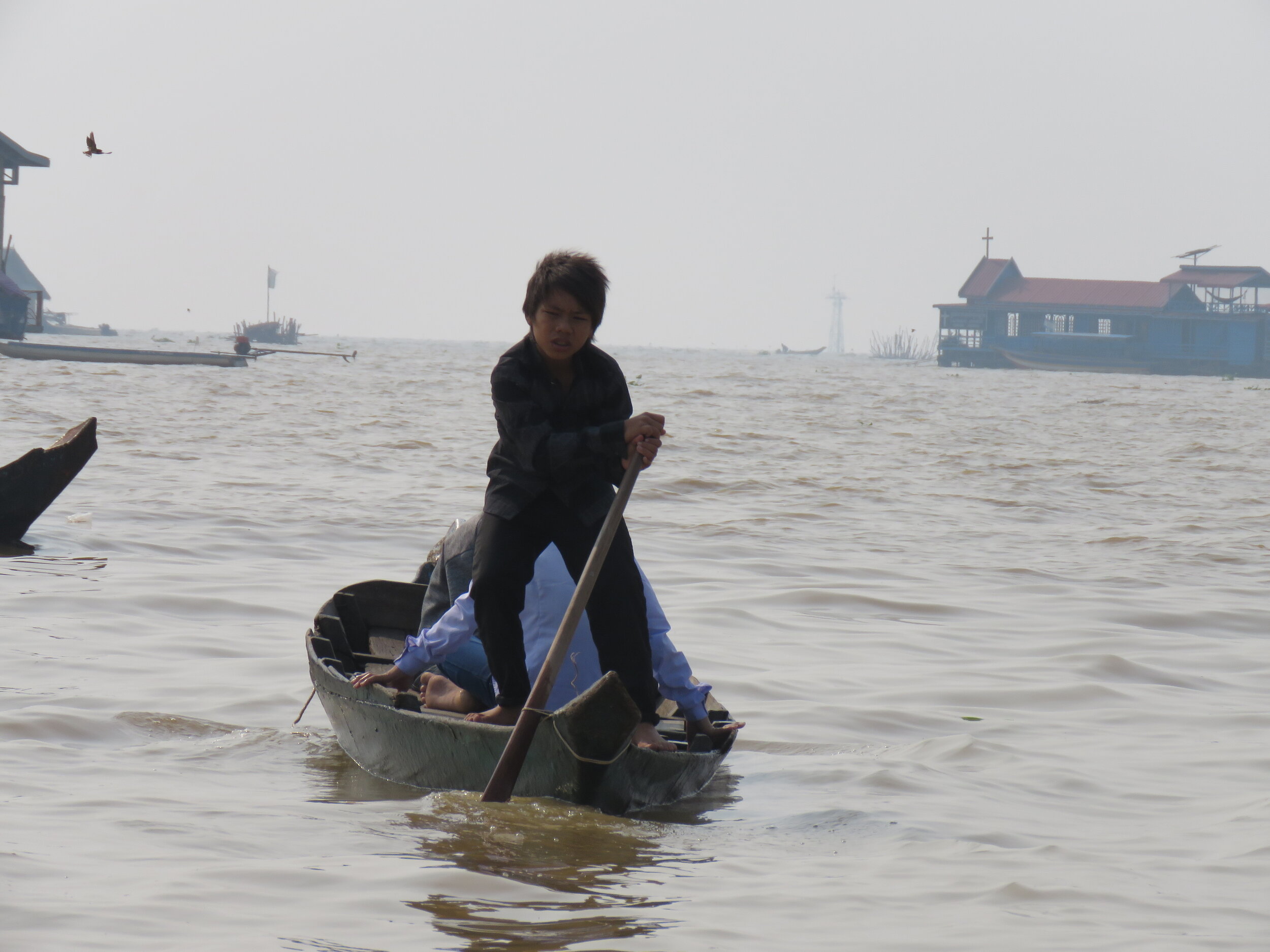

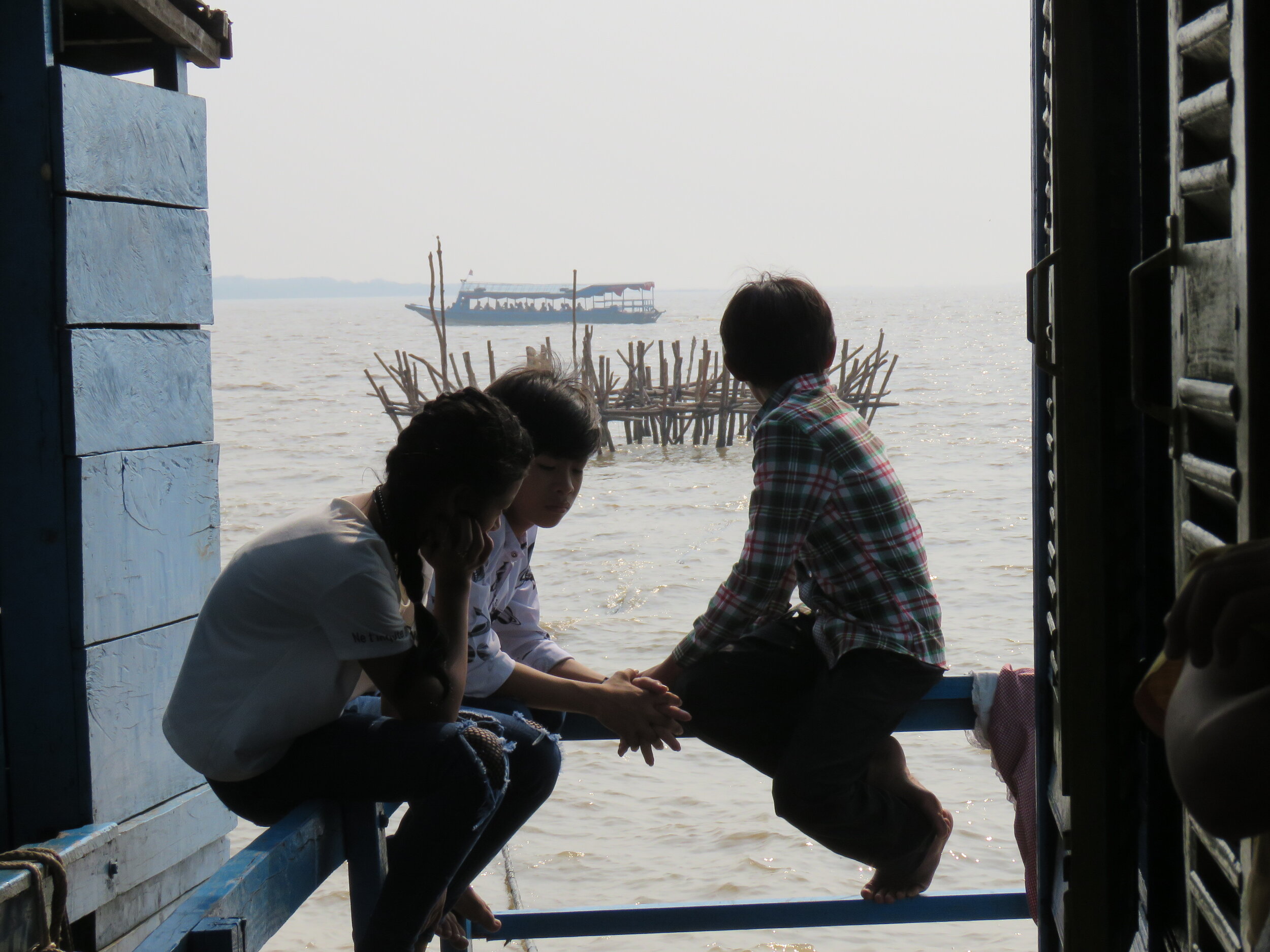
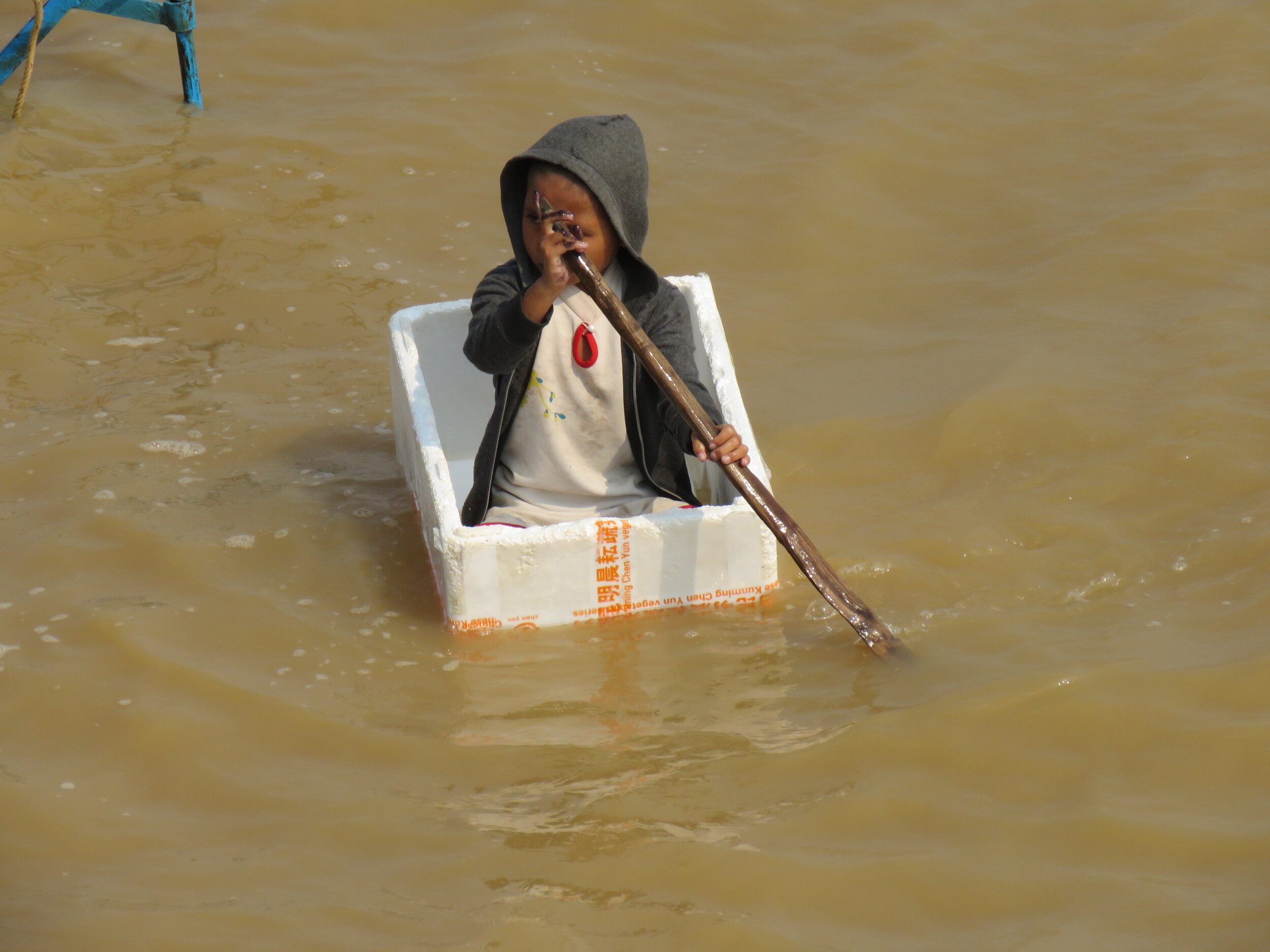
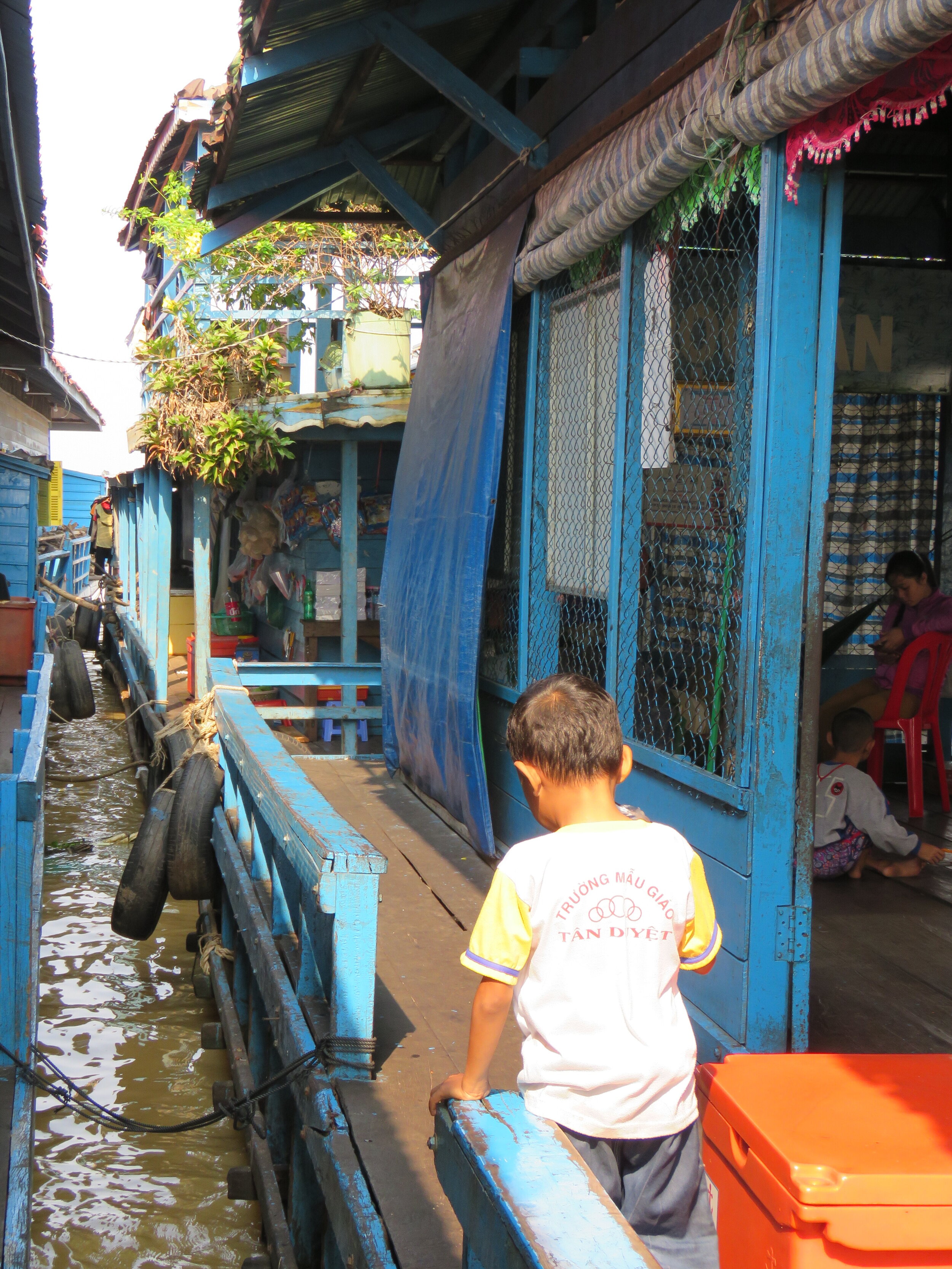
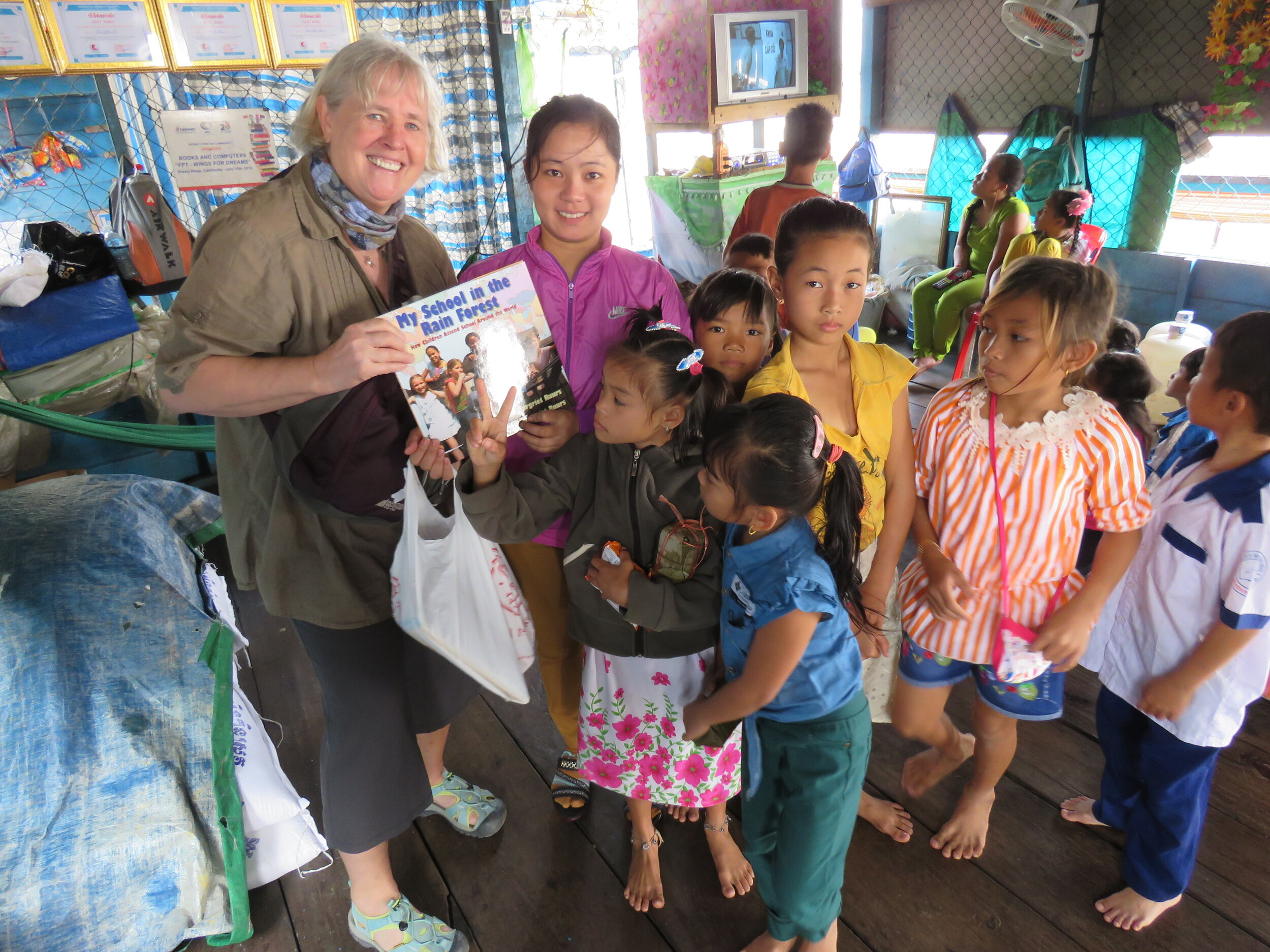
Back on land, it is amazing to see the variety of road side stands - that is, to us they are road side stands but here they are the shops. I love seeing how people use their specific skills or whatever resources their immediate area offers.
In a stretch of about one kilometre along the main road you might see stand after stand offering coconuts and pineapples. The next stretch offers foot long lengths of bamboo, all standing up straight in baskets. These hold steamed sticky rice with beans.
Motorbike turned farm stand.
Someone sells chickens, live ones trying to scratch the dirt under the basket that holds them captive. Her neighbour offers fish for sale - small live catfish huddled in a plastic tub of water with a piece of wood on top to keep them from jumping out.
There are carvers of beautiful teakwood chairs and beds. Or people who build ornate stands with spirit houses on it. Each household needs one or more of these small altars so there must be a brisk business in spirit houses, often painted golden or orange. Some women sell fabulous deep fried bananas or pineapple pastries. A haircut costs one dollar, also in a roadside stand.
Perhaps one of the most innovative sellers is in the towns too far from a gas station. Everyone needs gasoline to drive their motorbike but it is too expensive to drive to the city. So someone goes to stock up and then sells it in small portions in empty pop bottles.
At one point I asked our tuk-tuk driver to stop at a roadside stand selling round green things. I wondered what they were so we bought one bundle. Turned out to be the fruit pods of the lotus flower which we saw growing along the roads in shallow water. You break open the pod to take out a green ‘nut’. Then you break open this nut to reveal a white inside which you pop into your mouth. It didn’t have much flavour but is an interesting texture, somewhere between a berry and a nut.
We enjoy experiencing Cambodian food. Besides eating lotus seeds, we’ve tried fried bananas with papaya sauce; river fish amok - a stew with rice served in banana leaf; banana blossom salad; pineapple spring rolls and fried glass noodles. I draw the line when our cheerful guide Po asks me if I’d like to try some deep fried tarantula. He laughs telling us about frog sausages. Or perhaps you prefer chopped up tree ants in fish paste? We see tall poles with lines hung with bunched up plastic sheets along the road. Their purpose? To catch crickets at night when a light attracts them to the plastic. Another deep fried Cambodian delicacy! You can wash it all down with scorpion rice wine. When I googled the latter, I discovered there’s also cobra wine. But don’t worry, the article states, the alcohol cancels out the poison…
Tarantula anyone?
And just in case you think everything is fabulous: we had lunch at a very interesting hammock restaurant. I loved the experience. As we walked over, all we saw was enormous wooden platforms with hammocks. Someone came over and spread a large wicker mat for us on the wooden platform. We climbed up and swung in a hammock until a pot of soup with cut up chicken pieces arrived. I ate some fried morning glory and we had rice (no chopsticks in Cambodia). Then we relaxed in the hammocks again as families around us did the same. It was fun until something hit me, about a day later. Severe food poisoning. I really don’t know if it was here, or something else I ate but I was sick as a dog and couldn’t eat a thing for three days. Had to cut down on hiking as it left me drained of all energy. I am just grateful we brought plenty of medicine and gravol.
Hammock restaurant
In a next Cambodia blog, we’ll take you to Angkor Wat and on our trek.
BOOKS about Cambodia
Here are some fascinating videos about Tonle Sap:
Part 1 of a video on the Mekong and Tonle Sap: https://youtu.be/uUfMtk2KKYU
Part 2: https://youtu.be/oJ1da7Jp-OY
Part 3: https://youtu.be/YdFHumMcm_Y










